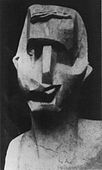
Groupe de femmes
Groupe de femmes, also called Groupe de trois femmes, or Groupe de trois personnages, is an early Cubist sculpture created circa 1911 by the Hungarian avant-garde, sculptor, and graphic artist Joseph Csaky (1888–1971). This sculpture formerly known from a black and white photograph (Galerie René Reichard) had been erroneously entitled Deux Femmes (Two Women), as the image captured on an angle showed only two figures. An additional photograph found in the Csaky family archives shows a frontal view of the work, revealing three figures rather than two. Csaky's sculpture was exhibited at the 1912 Salon d'Automne, and the 1913 Salon des Indépendants, Paris. A photograph taken of Salle XI in sitiu at the 1912 Salon d'Automne and published in L'Illustration, 12 October 1912, p. 47, shows Groupe de femmes exhibited alongside the works of Jean Metzinger, František Kupka, Francis Picabia, Amedeo Modigliani and Henri Le Fauconnier.
Groupe de femmes
(Groupe de trois personnages)
1911-12
Sculpture (original plaster). Csaky photographic archives (AC. 109)
Dimensions and whereabouts unknown (presumed destroyed)
At the 1913 Salon des Indépendants Groupe de femmes was exhibited in the company works by Fernand Léger, Jean Metzinger, Robert Delaunay, André Lhote, Raymond Duchamp-Villon, Jacques Villon and Wassily Kandinsky.[1]
The whereabouts of Groupe de femmes is unknown and the sculpture is presumed to have been destroyed.











